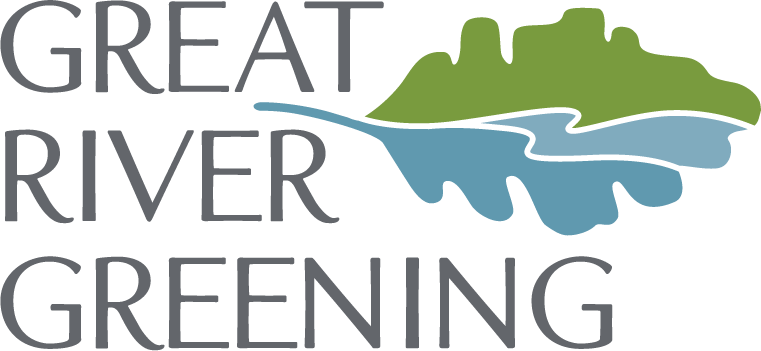Restoring the Mississippi river corridor in Saint Paul and beyond
Great River Greening and partners have collaborated for more than a dozen years to restore the bluff lands and floodplains that frame the Mississippi River in Saint Paul and surrounding communities. As we expand our work to other regions of the state, our roots continue to be anchored in Saint Paul. Moreover, our work in connecting a natural wildlife and recreational corridor along the Mississippi has elevated our conservation results to a new level, with an array of new projects now underway.With support from private and public partners, Great River Greening is elevating its work adjacent to the Mississippi River, with a goal of stitching together a functional natural corridor to service the needs of area wildlife and people that call the Twin Cities home.Greening and partners are working together to restore these sites:
- Trillium Nature Preserve is a new 37 acre site located in the heart of a heavily urbanized area just north of downtown Saint Paul, along the Trout Brook Regional Trail. The project will create an ecologically-important wildlife corridor that will connect with the Mississippi River, and will include day-lighting a trout brook that was filled in and put underground by the railroad industry. It will also include restoring prairie, oak savanna, oak woodland and big woods habitat to a natural valley that was lost many years ago. With the restoration of the natural valley, Greening and Saint Paul Parks and Recreation will restore the neighborhood’s connection to the natural environment.
- Crosby Lake is a popular fishing lake within the Crosby Park Preserve, a 500-acre oasis of woods and wetlands along the Mississippi River visited by tens of thousands of people throughout the year. Although Crosby Lake currently meets water quality standards, it has not been immune to urbanization. Water quality has declined since 2005 and chlorophyll-a has increased. In partnership with Saint Paul Parks and Recreation, Greening will utilize state-of-the-art bioengineering strategies to correct areas of erosion, improve water clarity, and protect fish habitat. o Indian Mounds Park, Saint Paul’s oldest city park ( Indian Mounds Park established in 1893), is a site of high cultural and ecological significance within the Metro Mississippi corridor due to its six 2,000-year-old burial mounds and one of very few surviving remnants of native oak savanna left in the Metro Mississippi portion of the Mississippi River Valley. It is situated upstream from where the first historic Kaposia village site was located. The park has paved trails that traverse the bluffs, with outstanding views of the Mississippi River valley and of the Saint Paul and Minneapolis skylines.
- Cherokee Park was first known as Cherokee Heights Tourist Camp in the 1920s and was a popular camping spot around the turn of the century. Portions of the bluff edge along the park were maintained for viewing so it was a popular spot for visitors to view the river valley and downtown Saint Paul. Walking trails are located throughout the park and several of them were probably used around the turn of the century as a way to get to the base of the bluff and the Mississippi River. A rare prairie remnant was found in 2001, roughly one acre in size. The prairie with some 60 native species present has high diversity, but it is rapidly disappearing due to the invasion of tree and shrub species and an eroding trail that runs through the center of the prairie. Greening volunteers and partners have also helped to improve the oak savanna and woodland that surround the prairie.
Great River Greening has been approved for funding from Minnesota’s Outdoor Heritage Fund through the Metro Big Rivers Partnership and by the Minnesota Environment and Natural Resources Trust Fund as recommended by the LegislativeCitizen Commission on Minnesota Resources (LCCMR), through Great River Greening’s membership in the Metro Conservation Corridors partnership for this important work.These generous grants provide an outstanding opportunity for dramatic conservation results that will be felt for generations. But they come with a challenge- Greening must also raise private matching dollars. Simply put, these projects cannot move forward without the support of generous individuals like you. If you are interested in supporting this program, please contact Rob Nygaard at 651-665-9500 x18 or rnygaard@greatrivergreening.org.
